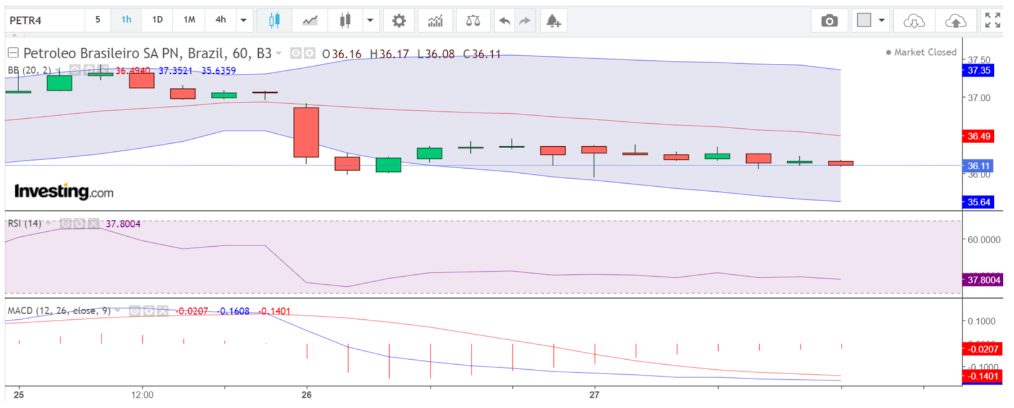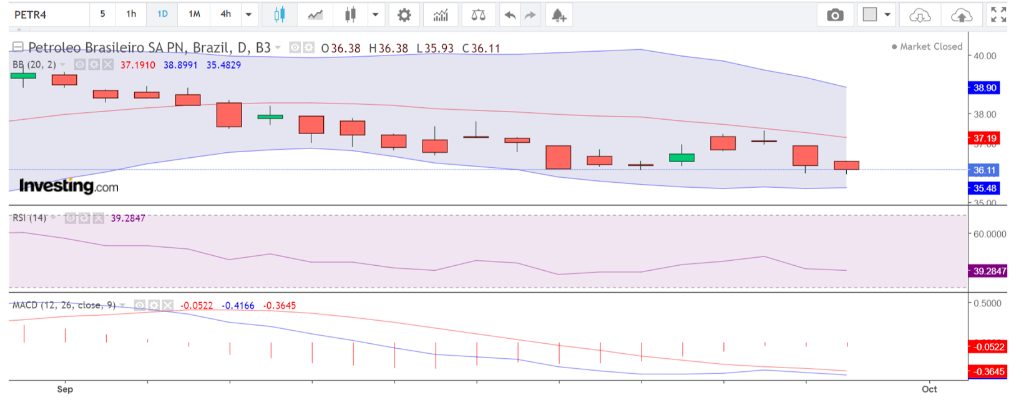CFD Trading in Brazil



Contract for difference (CFD) trading is gaining traction in Brazil as a fast-paced alternative to traditional investment methods, though regulatory hurdles persist.
As a derivative, CFDs allow you to speculate on the price movements of assets like shares in Petróleo Brasileiro S.A, without actually owning them, offering flexibility and requiring less capital.
Want to start CFD trading in Brazil? This beginner’s guide will launch your journey.
Quick Introduction
- With CFDs, you can speculate on rising and falling markets by taking long or short positions, offering greater flexibility than traditional investment vehicles like direct stock dealing.
- CFDs offer leverage, allowing you to control larger positions with less capital. However, leverage amplifies gains and losses. Therefore, CFD trading requires careful risk management, with tools like stop-loss orders helping to limit exposure and minimize losses.
- CFDs are not explicitly illegal in Brazil, but the regulatory environment overseen by the Brazilian Securities and Exchange Commission (CVM) is restrictive. Brokers face significant challenges, and some have had to limit or remove CFD offerings to comply with local rules.
Best CFD Brokers in Brazil
Based on our traders and experts' tests, these 4 platforms are the frontrunners for CFD traders in Brazil:
How CFD Trading Works
CFDs provide an opportunity to trade financial markets without owning the actual asset. Instead, you predict whether the price of an asset will increase or decrease.
One of the most appealing aspects of CFD trading is leverage. This allows you to open large positions while only committing a fraction of the total value, known as the margin.
Let’s say you believe that The Bovespa Index, best known as Ibovespa (the benchmark index of about 86 stocks traded on the B3), will experience an upward trend, you’ll enter a CFD buy position.
Consider that each contract is valued at $R (BRL) 20,000, and your brokerage requires a 5% margin. To take a position on 10 contracts, your margin requirement would be 10,000 (BRL 20,000 per contract x 10 contracts x 5%).
If the Ibovespa rises to BRL 21,000, the price increase would yield BRL 1,000 per contract. By closing your position, you would realize a total profit of BRL 10,000 (10 contracts x BRL 1,000), excluding any fees your broker charges.
Conversely, if the index falls to BRL 19,000, you would lose BRL 10,000, illustrating the inherent risks associated with CFD trading; losses and gains are magnified.
Before you start CFD trading, it’s essential to grasp the margin requirements and potential risks.For anyone new to this type of trading, a demo account is an excellent introduction to practice strategies and build confidence.
What Can I Trade?
In Brazil, CFDs provide a wealth of opportunities across various financial markets, both domestically and globally:
- Stock CFDs – Speculate on individual BRL company stocks, such as Petrobras, a state-owned oil company that plays a significant role in the global energy market. Vale: A metals and mining corporation and one of the country’s largest logistics operators. You can trade these leading firms as CFDs without purchasing the actual shares.
- Index CFDs – The Ibovespa is the benchmark index of about 86 stocks traded on the B3. Traders often choose CFDs to speculate on the Brazilian market’s overall performance. Additionally, you could explore CFDs on major global indices like the Dow Jones or the NASDAQ.
- Forex CFDs – The Brazilian Real (BRL) is actively traded in the foreign exchange market. You may be able to speculate on popular currency pairs, including USD/BRL and EUR/BRL, although Brazil’s CVM has implemented restrictions.
- Commodity CFDs – Access commodities such as coffee, sugar, and soybeans, which Brazil is a top exporter of globally.
- Crypto CFDs – Trade cryptocurrency CFDs like Bitcoin and Ethereum for access to the highly volatile cryptos.
Is CFD Trading Legal In Brazil?
CFD trading is a legal grey area in Brazil. They didn’t become widespread in Latin America until the 2010s, so regulations are still evolving.
The Brazilian Securities and Exchange Commission (CVM) oversees the country’s financial markets but does not actively regulate CFD products.
As a result, Brazilian traders often engage in international brokers that are regulated by authorities in other countries, such as the FCA (UK), CySEC (Cyprus), or ASIC (Australia).
However, providers face restrictions when marketing to Brazilian customers. eToro, for example, does not offer forex CFDs in Brazil due to regulatory hurdles, as reported by Finance Magnates.
The CVM has also warned about the risks of trading with unauthorized brokers. Be cautious and select providers with solid regulatory oversight from well-known authorities.
CFD trading is not regulated domestically, and Brazilian traders should be mindful of the risks associated with trading through international platforms.
Is CFD Trading Taxed In Brazil?
Profits from CFD trading may be subject to capital gains tax, just like other investment income.
The tax rate on capital gains can vary, but for individuals, it follows a progressive rate based on the total amount of gains:
- 15% for gains up to BRL 5 million
- 17.5% for gains between BRL 5 million and BRL 10 million
- 20% for gains between BRL 10 million and BRL 30 million
- 22.5% for gains exceeding BRL 30 million
Brazilian tax authorities require that individuals self-declare their capital gains from CFD trading, as foreign brokers typically don’t report this information to Brazil’s tax authority (Receita Federal). Track your profits and losses and report them in your annual tax return.
Losses incurred from CFD trading can offset gains in the same tax period, reducing the taxable amount. However, the rules around loss carryover can be intricate.
In Brazil, capital gains from financial markets, including CFDs, should typically be reported and paid monthly if the profits exceed BRL 35,000 in a given month. Traders must generate and pay a DARF (Documento de Arrecadação de Receitas Federais) for the applicable tax due.
An Example Trade
To demonstrate how CFD trading in Brazil actually works, let’s walk through a detailed trade I made.
Background
The São Paulo Stock Exchange is a stock and over-the-counter market based in Sao Paulo, Brazil. Founded in 1890 as Bolsa de Valores de São Paulo (BOVESPA), it is now part of B3 SA or Brasil, Bolsa, Balcão (B3), formed following the 2008 exchange merger with the Brazilian Mercantile & Futures Exchange.
Petrobras is a publicly traded corporation in the oil, natural gas, and energy industries. It has expertise in exploration and production, resulting from decades of development in the Brazilian basins, especially in deep and ultra-deep waters.
Fundamental Analysis
Before considering a stock CFD day trade, you must rapidly evaluate the key metrics of the stock’s share price. Have a list of the critical metrics you prefer to guide your decision, such as the P/E ratio, 52W high and low, the 1-year change, market capitalization, and net income.
Then, search for recent news about the company, positive or negative. Be mindful that the firm might be subject to swings based on macroeconomic news; for example, would Petrobras be linked to the price of oil on the commodities markets?
Finally, search for analyst recommendations because they’ll be part of investment banks or publishers like Bloomberg and Reuters, with access to resources unavailable to retail traders.
Petrobras Key Metrics
- P/E ratio: 6.51
- 52 WK range: 28.26 – 40.92
- 1YR change: 19.09%
- Market Cap: 490.96 R$
- Net Income: 78.76 R$
- Analyst Sentiment: Buy
Technical Analysis
I often look to analyze a stock across two timeframes, one higher and one lower. Typically, my higher timeframe analysis will be (at most) D1 as I never want to buy and hold, only day or swing trade. I’ll look at the 4HR or 1HR chart for the lower timeframe.
Using the two chart/time frame method lets me quickly discover if price action exists in the lower time frame and if a trend is developing or being supported in the higher timeframe.
I limit the technical indicators I use to make decisions. If your charts become too cluttered, you’re probably duplicating the crucial information you need to make an informed decision.So, I’ll use indicators that illustrate momentum, volatility, trend, oversold/overbought levels and potential stop and reverse. A combination of Bollinger Bands, MACD, and RSI should cover this.
The candles or bars you use should help you quickly identify price action. I prefer Heikin Ashi bars/candles because the candlestick patterns generated are smoother and more easily identified.
1Hour Timeframe
In the 1HR chart below, we can see the following:
- The HA pattern reveals that the stock is in a tight range and not trending. The bearish momentum may be exhausted.
- The RSI reading at 37 suggests that the stock is oversold.
- The moving averages of the MACD are close to converging.
- The BBs are narrowing.

D1 Timeframe
The D1 timeframe supports my 1HR analysis:
- The BBs have narrowed.
- The HA price action suggests volatility and momentum have faded.
- The RSI indicates an oversold stock.
- The moving averages in the MACD have narrowed and look close to convergence or crossover.

Execution
I’ve decided to go long. I entered at 36.11, and a stop loss order was placed at 35.50.
I’m not placing a take profit limit order, but I will time limit the trade; if bullish price action fails to materialize within two days, I’ll close the trade, whether in loss or profit.
Technical analysis has no guarantees, but technical indicators provide a valuable service for all active traders. They give you a reason to get in and out, help you place stop-loss and profit-limit orders, and allow you to calculate your risk per trade (position size) quickly.
For this trade, I’m risking 1% of my $10,000 account ($100) and using 1:5 leverage, so by using a CFD, I’m controlling five times more stock than I would if I were buying and holding the stock.
Bottom Line
While the CVM does not regulate it, traders can access CFDs through reputable foreign brokers.
However, due to the inherent risks of leverage and volatility, it’s essential to trade responsibly and employ proper risk management strategies.
Understanding the tax obligations, including reporting capital gains and paying taxes, is vital for complying with Brazilian law.
To get going, see DayTrading.com’s choice of the top CFD day trading platforms.
Recommended Reading
Article Sources
- The Brazilian Securities and Exchange Commission (CVM)
- Documento de Arrecadação de Receitas Federais (DARF)
- Brazil’s tax authority (Receita Federal)
- B3 SA or Brasil, Bolsa, Balcão (B3)
- Petrobras
- eToro Opens Up All Assets to Brazilian Users, Exempts Forex CFDs - Finance Magnates
The writing and editorial team at DayTrading.com use credible sources to support their work. These include government agencies, white papers, research institutes, and engagement with industry professionals. Content is written free from bias and is fact-checked where appropriate. Learn more about why you can trust DayTrading.com



